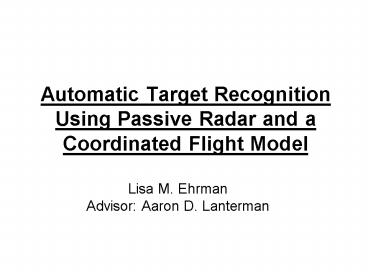Automatic Target Recognition Using Passive Radar and a Coordinated Flight Model - PowerPoint PPT Presentation
1 / 33
Title:
Automatic Target Recognition Using Passive Radar and a Coordinated Flight Model
Description:
Automatic Target Recognition Using Passive Radar and a Coordinated Flight Model. Lisa M. Ehrman ... Transmitting signal not designed for target detection & tracking ... – PowerPoint PPT presentation
Number of Views:941
Avg rating:3.0/5.0
Title: Automatic Target Recognition Using Passive Radar and a Coordinated Flight Model
1
Automatic Target Recognition Using Passive Radar
and a Coordinated Flight Model
- Lisa M. Ehrman
- Advisor Aaron D. Lanterman
2
What is ATR?
- Automatic Target Recognition (ATR)
- Ability to classify a target
- Two Schools of Thought
- Create images of the targets, which enable you to
conduct ATR - Conduct ATR directly on data, ie target RCS
- Our Approach
- Want to identify aircraft model
- Select Passive Radar as illuminator
- Use RCS to identify aircraft model
3
What is Passive Radar?
- Active Radar
- System has transmitter and receiver
- Transmitter sends pulses which bounce off target
- Determine target position and velocity from
energy that bounces back
- Passive Radar
- System only has a receiver
- System exploits transmitters already available,
- ie TV, FM Radio used to determine target
position and velocity
4
Why Use Passive Radar?
- Benefits
- Covert
- Cheap
- Not as susceptible to bad weather or stealth
- Lower frequencies ? RCS varies more slowly with
time - Challenges
- Transmitting signal not designed for target
detection tracking - Challenges have already been overcome by Howland,
Herman, Lockheed Martin,
5
Radar Cross Section (RCS)
- RCS Equation
- RCS Depends on
- Incident Azimuth and Elevation
- Observed Azimuth and Elevation
AZI
AZO
ELI
ELO
PD
PR
Transmitter
Receiver
6
Coordinated Flight Model
- Goal
- Estimate Aircraft Orientation from Position
- Key Parameters
- Heading
- Pitch
- Roll
- Assume Yaw 0
7
Modeling RCS
- 1) Use FISC to Model RCS as function of
- Incident Azimuth and Elevation
- Observed Azimuth and Elevation
2) Use NEC2 to Model Receiving Antenna Gain
- 3) Use AREPS to Model Propagation Losses
- Between Transmitter and Aircraft
- Between Aircraft and Receiver
8
Creating Noisy Profiles
- Problem
- In Absence of Real Data, Simulate the Power
Profile Arriving at the Receiver - Add White Gaussian Noise
- Assume phase is equally likely everywhere in
0,2p - Traces out a circle in the Complex Plane, whose
radius is the RCS magnitude - Model the thermal noise as normally distributed
white Gaussian noise, acting independently in the
Real and Imaginary directions - Add the noise to the profile using
9
Computing Noise Power
- Noise Figure Vs. Noise Power
- Noise Figure Accounts for
- Out-of-Band Interference
- Direct-Path Interference
- Solution
- Sweep Noise Figure
10
Identifying the Aircraft
- Use Loglikelihoods to Identify Aircraft Model
- Rician Model Compares the Library of Profiles to
the Simulated Profile at the Receiver - Treat each point in time as an independent sample
of a process - Loglikelihood is given by
- The aircraft with the largest loglikelihood is
matched to the target
11
Geometries Tested
- Simple Scenarios
- Straight and Level Flight
- Banked Turn
- Complex Scenario
- Real Flight Profile
The flight pattern is a F-15C trajectory,
obtained from the Joint Helmet Cuing system,
mission JH-16, conducted by the 445th Flight
Test Squadron at Edwards Air Force Base in May
2000.
12
Straight and Level FlightProbability of Error
Vs. Noise Figure
13
Straight and Level FlightPower Profiles
14
Straight and Level FlightConfusion Matrices
- Noise Figure 35 dB, Noise Power -166 dB
- Noise Figure 40 dB, Noise Power -161 dB
- Noise Figure 45 dB, Noise Power -156 dB
15
Banked-Turn Flight ProfileProbability of Error
Vs. Noise Figure
16
Banked-Turn Flight ProfilePower Profiles
17
Banked-Turn Flight ProfileConfusion Matrices
- Noise Figure 45 dB, Noise Power -156 dB
- Noise Figure 50 dB, Noise Power -151 dB
- Noise Figure 60 dB, Noise Power -141 dB
18
F-15 Trajectory 3-D
Z
Y
X
19
F-15 Trajectory Top View
20
F-15 Trajectory, Real AnglesProbability of
Error Vs. Noise Figure
21
F-15 Trajectory, Real AnglesPower Profiles
22
F-15 Trajectory, Real AnglesConfusion Matrices
- Noise Figure 55 dB, Noise Power -146 dB
- Noise Figure 60 dB, Noise Power -141 dB
- Noise Figure 65 dB, Noise Power -136 dB
23
F-15 Trajectory, Est. AnglesProbability of
Error Vs. Noise Figure
24
F-15 Trajectory, Est. AnglesPower Profiles
25
F-15 Trajectory, Est. AnglesConfusion Matrices
- Noise Figure 55 dB, Noise Power -146 dB
- Noise Figure 60 dB, Noise Power -141 dB
- Noise Figure 65 dB, Noise Power -136 dB
26
Estimating Aircraft Heading
Z
Y
X
27
Estimating Aircraft Pitch
Z
Y
X
28
Estimating Aircraft Roll
Z
Y
X
29
Conclusions
- Performance Varies Greatly with SNR
- If you can get SNR 1, this is a viable approach
- If you have trouble correctly identifying
aircraft and SNR 1, you probably need a more
sophisticated means for estimating aircraft
orientation
30
Future Work
- Finish the FISC Database, using more
sophisticated techniques - Determine whether or not the out-of-band and
direct-path interference can be accounted for in
this manner - Determine impact of errors in position estimates
31
BACK-UP SLIDES
32
SYSTEM DESCRIPTION
- Transmitter
- GPS Location 520100 N, 050300 E
- Altitude (ASL) 375 m
- Frequency 100 MHz
- Peak Power 100 kW
- Type Omni-directional
- Polarization Horizontal
- Receiver
- GPS Location 520636 N, 041926 E
- Altitude (ASL) 100 m
- Direction 320 (0N, 90E, 180S, 270W)
33
RECEIVER GAIN PATTERN































